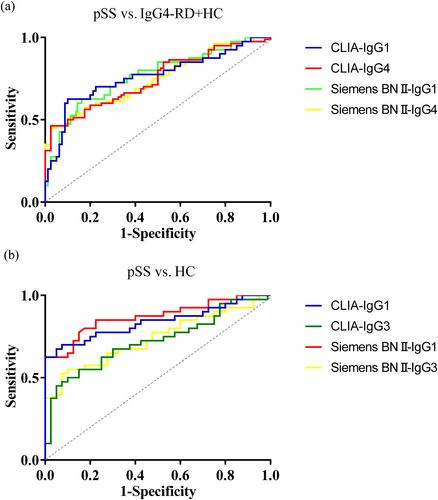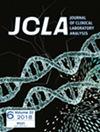Detection of IgG subclasses (IgGSc) is vital for the diagnosis and management of disease, especially IgG4-related diseases (IgG4-RD). This study aimed to evaluate the performances of the chemiluminescent immunoassay (CLIA) for detecting IgGSc and diagnosing IgG4-RD by IgGSc.
A total of 40 individuals with IgG4-RD, 40 with primary Sjogren's syndrome (pSS), and 40 healthy controls (HCs) were enrolled. Serum samples were collected for the simultaneous detection of IgG1, IgG2, IgG3, and IgG4 by the Siemens immunonephelometric assay and the CLIA. The correlation analysis was performed, and diagnostic value was analyzed by the receiver operating characteristic (ROC) curve.
Patients with IgG4-RD had higher IgG4 (p < 0.001) and lower IgG1 (p < 0.001) than those with pSS, and HC. The results by the Siemens immunonephelometric assay and the CLIA showed a strong correlation in detecting IgG1, IgG2, IgG3, and IgG4 (r = 0.937, r = 0.847, r = 0.871, r = 0.990, all p < 0.001, respectively). The sum of IgG1, IgG2, IgG3, and IgG4 using two assays strongly correlated with total IgG by the IMMAGE 800 (r = 0.866, r = 0.811, both p < 0.001, respectively). For discriminating IgG4-RD from pSS and HC, no significant differences were observed in CLIA IgG4 and Siemens immunonephelometric assay IgG4 (z = 0.138, p = 0.891), which provided the area under the curves (AUCs) of 0.951 (p < 0.001) and 0.950 (p < 0.001), respectively. The AUCs of CLIA IgG1 and Siemens immunonephelometric assay IgG1 in distinguishing pSS from IgG4-RD and HC were 0.761 (p < 0.001) and 0.765 (p < 0.001), respectively, with no significant differences (z = 0.228, p = 0.820).
The CLIA and the Siemens immunonephelometric assay appeared to have good consistency with comparable diagnostic value in detecting IgGSc, especially IgG4, and IgG1 that can accurately identify IgG4-RD or pSS in clinical practice.




